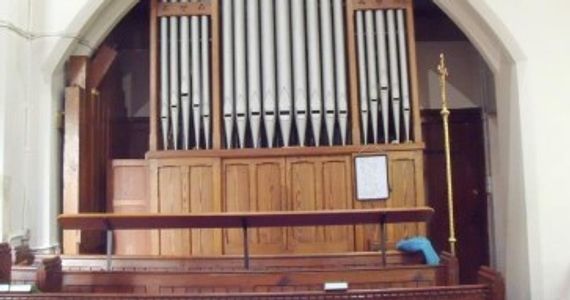History of Our Church
Perhaps the most surprising thing about this little church is its youth
At first sight the flint-dashed exterior hints at pre-Reformation times. It was, however, built during the last years of Queen Victoria’s reign.
The present church is not the first to stand on this spot. In 1834 the Vicar of Harlow, whose parish boundaries included the village of Potter Street and the Hamlet of Foster Street, felt the need for a daughter church to serve the people of Potter Street. The present site on the edge of Harlow Common was purchased, and the first church was built as a Chapel-of-ease. Assistant clergy from the parish church were appointed as Chaplains, and the villagers no longer had to walk the two miles to St Mary’s in Churchgate Street.
Old photographs show the first building as having little to commend it architecturally. It was a square, cement rendered box, with its shallow roof practically hidden by mock battlements.
By 1877, when the Reverend Henry Elwell was appointed vicar, the then village of Potter Street had grown to a size that warranted the extension of the church. Accordingly in 1888 the east wall was taken down and the present Chancel added. The east window of the original church has been preserved and can be seen on the south side of the choir.
Five years later, in 1893, permission was granted to pull down the old church, and the new Nave was built to match the Chancel.
After a further five years, just before the turn of the century, in 1898
The tower with its wooden-shingled spire was added to complete the church as it now stands.
Hanging in the tower is a fine set of eight bells from the foundry of John Taylor of Loughborough. The treble weighs a few ounces over three hundredweight, and the tenor, the largest of the peal, just over twelve hundredweight. The first full peal was rung in November 1905, the year the bells were hung. The actual ringing is unique in that, in order to give sufficient length of rope in a small tower, the ringers actually stand in the main porch.
James Elwell succeeded his father as vicar of the parish.
His love and concern for the welfare of the children of the parish was so great that it led benefactors to commemorate him in an unusual and lovely way.
A bequest was made which requires a gift to be made to the children of the church each Ascension Day, and for many years now a piece of gingerbread has been given to each child after the Ascension Day service.
Taken from a history of the church written by Fr Howard Gribble in 1965.
Our Organ

History
In the mid 1970’s, the original organ had problems with its mechanism and was inadequate. A local Organ Builder, Brian Bunting of Epping, was commissioned to improve/replace the organ.
A two-manual organ from the Congregational Church in Henham, built in the 1870’s, was brought to St.Mary Magdalene Church.
Mr.Bunting overhauled it, and to make the organ more versatile he added several ranks of pipes, some from the old St.Mary Magdalene’s Organ.
During the rebuild work, the original labels have been lost so there is little information available on the history of either organ.

SPECIFICATION
2 Manuals with 56 keys, Pedal board with 30 keys.
* Denotes pipes from Henham Organ.
Great Organ
*Open Diapason 8ft 56pipes
*Principal 4ft 56pipes
*Fifteenths 2ft 56pipes
Stopped Diapason 8ft 56pipes
Flute 4ft 56pipes
Couplers
Swell to Great
Swell to Pedal
Great to Pedal
Pitch A = 460 at 18 C (65 F) i.e. +38 cents re Concert Pitch

SPECIFICATION
Swell Organ
*Dulciana 8ft 56pipes
*Gedact 8ft 56pipes
*Gemshorn 4ft 56pipes
Quint 1 1/3 ft (19th) 56pipes
Pedal Organ
*Bourdon 16ft 30pipes
Blower Electric
Wind Pressure -approx. 2 inches of water